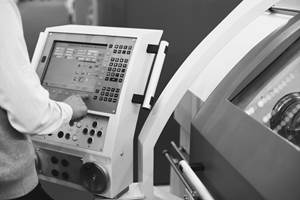Scanning CMM Technology Made More Affordable
While scanning CMMs have been around awhile, they haven't become a mainstay of general production mainly due to cost. There's little question as to the value that scanning can provide. Conventional CMM workpiece measuring processes are limited by the number of points that can be collected and analyzed in a reasonably time-efficient manner. Thus, point-by-point inspection in essence provides a spot check confirmation of certain workpiece features, but it can easily miss a variety of nonconforming geometry in between those checkpoints.
Share




While scanning CMMs have been around awhile, they haven't become a mainstay of general production mainly due to cost. There's little question as to the value that scanning can provide. Conventional CMM workpiece measuring processes are limited by the number of points that can be collected and analyzed in a reasonably time-efficient manner. Thus, point-by-point inspection in essence provides a spot check confirmation of certain workpiece features, but it can easily miss a variety of nonconforming geometry in between those checkpoints. For instance, taking just three points on a circle is a reasonably reliable check that the feature is in fact on center, but it tells very little about the true roundness of a hole. Indeed, the very same data could be derived from measuring the midpoints of an equilateral triangle.
With scanning, however, thousands of points can be taken where it was previously practical only to take a few. That allows manufacturers to check both dimensional conformity and geometry at once, providing a much more complete picture of the true quality level of a machining process without sacrificing measurement speed. Moreover, in reverse engineering applications, a more complete and accurate description of the original artifact can be obtained from the start.
The problem is, scanning CMMs historically have been expensive, which has precluded them from achieving a broad role in manufacturing applications. Carl Zeiss IMT Corp. (Minneapolis, Minnesota) hopes to change all that, however, with the introduction of its new Contura scanning CMM. It is a product, says the company, aimed at the "mid-range market" where touch-trigger CMMs have historically reigned.
The builder says the CMM is an affordable system offering both high accuracy and flexibility. It is suitable for a wide range of applications including inspection of castings, plastics, brake components, Styrofoam, medical implants and instruments, wheels, dies and molds, and a range of job shop applications.
The CMM comes with a new "VASTXT" probe head, based on technology first introduced in 1995. This enables the CMM to inspect a wider range of feature tolerances—including form, size and location—than practical with traditional probing technology. Measuring productivity is improved by eliminating multiple workpiece setups or the need to transport parts between different measuring machines. It also adds reliability to the measuring process by providing a high degree of data density. The machine is guaranteed to provide form measurements to a precision of 3.4 microns.
As for versatility, the machine can be operated in a number of modes. Fast single point measurements can be taken for simple tasks and to provide probing compatibility with other machines where a touch trigger probe head is required. Or, form elements can be scanned for all prismatic workpieces featuring circles, cones and planes. Speed and evaluation are preset as a function of the measuring task.
Known contours can be scanned for curves and free-form surfaces. Or unknown contours can be scanned with data-density-controlled speed settings—a mode that would be used to digitize free-form surfaces. Also, "self-centering" scanning can be used to guide the probe head in grooves, slots and other captured features.
The Contura CMM offers a measuring range of 28 by 40 by 24 inches, with accuracy stated as "u1=2.2 + L/300." Probe tip diameters go as small as 0.5 mm. Wraparound air bearings are used in all axes for high speed performance, and ceramic technology is used to enhance temperature stability. Zeiss guarantees its stated measuring certainty from 65° to 71° F.
The CMM is equipped with a 32-bit Pentium II-based "ISC" (Intelligent Scanning Control) controller, the first in a new generation of controls. It is available with two software packages. The UMESS package offers the highest level of functionality, while the Calypso offers CAD-based, Windows NT software. Both can be combined with the Holos software option, designed for measurement of 3D surfaces, and Dimension, a new package designed for reverse engineering tasks.
Related Content
The Link Between CNC Process Control and Powertrain Warranties
Ever since inventing the touch-trigger probe in 1972, Sir David McMurtry and his company Renishaw have been focused on achieving process control over its own manufacturing operations. That journey has had sweeping consequences for manufacturing at large.
Read MoreThe Many Ways of Measuring Thickness
While it may seem to be a straightforward check, there are many approaches to measuring thickness that are determined by the requirements of the part.
Read MoreHelp Operators Understand Sizing Adjustments
Even when CNCs are equipped with automatic post-process gaging systems, there are always a few important adjustments that must be done manually. Don’t take operators understanding these adjustments for granted.
Read MoreHow to Choose the Correct Measuring Tool for Any Application
There are many options to choose from when deciding on a dimensional measurement tool. Consider these application-based factors when selecting a measurement solution.
Read MoreRead Next
Registration Now Open for the Precision Machining Technology Show (PMTS) 2025
The precision machining industry’s premier event returns to Cleveland, OH, April 1-3.
Read MoreBuilding Out a Foundation for Student Machinists
Autodesk and Haas have teamed up to produce an introductory course for students that covers the basics of CAD, CAM and CNC while providing them with a portfolio part.
Read MoreSetting Up the Building Blocks for a Digital Factory
Woodward Inc. spent over a year developing an API to connect machines to its digital factory. Caron Engineering’s MiConnect has cut most of this process while also granting the shop greater access to machine information.
Read More






























